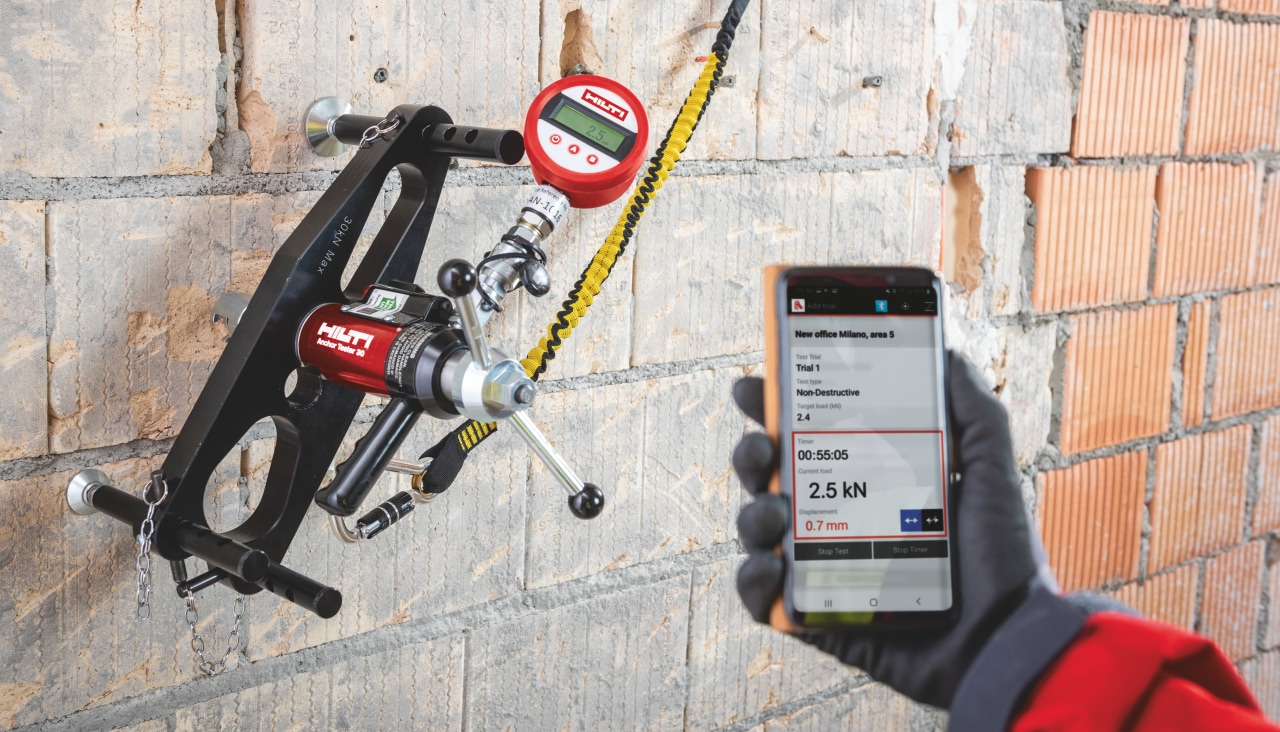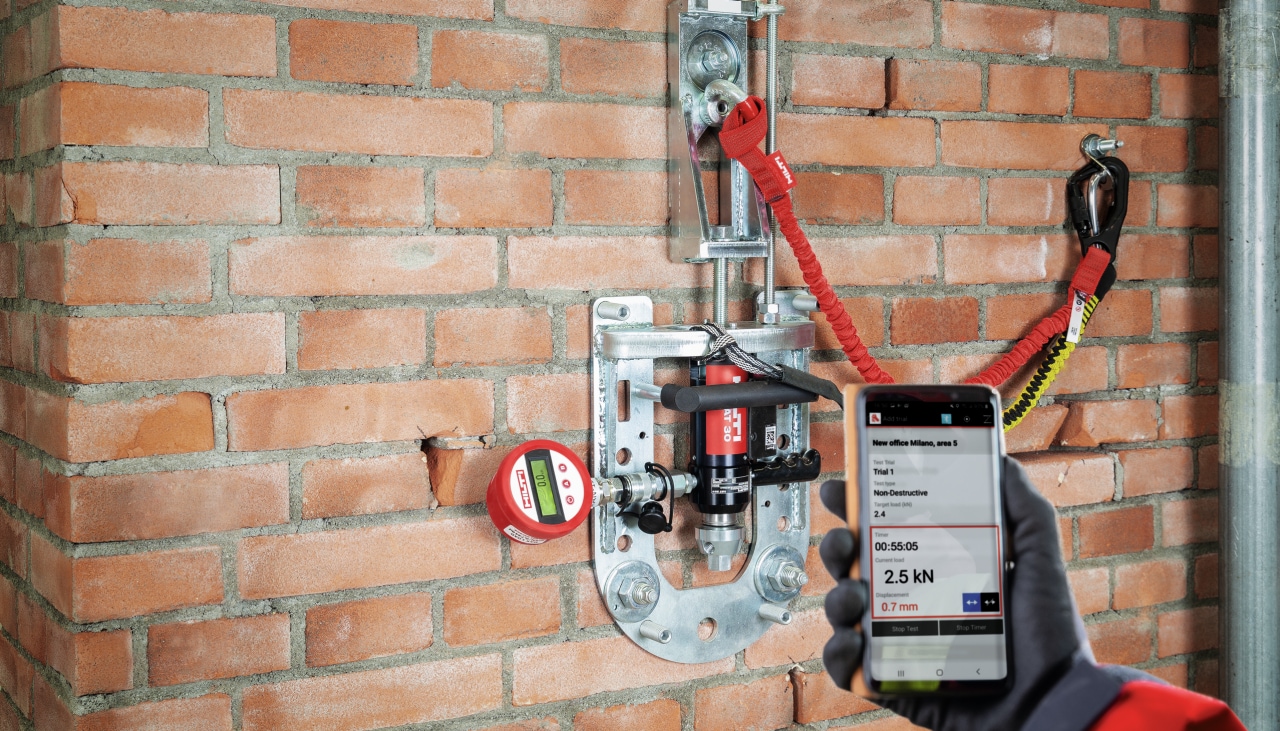- Home
- Services
- Quality and Testing
- Anchor Site Testing

On-site testing of anchors
Determination of design resistance and installation quality testing for construction
Is the combination of anchor and base material missing from the technical documentation you're using? Or are you looking to proof load fasteners as part of installation quality documentation? Let the Hilti anchor site testing service help you determine missing resistance values or provide the basis for your assessment of installation quality.
Why Hilti for on-site testing of anchors and rebar?

Expert on-site support from our engineers
We have developed a rigorous, methodical approach to anchor testing, carried out by a highly-trained team of engineers. This helps to avoid common testing pitfalls.

Determination of resistance tests
Tensile or shear tests to enable anchor design for unknown or uncertain base materials
Who the service is for: Engineers/designers
When it's needed: You have insufficient data to determine anchor resistance for safe, efficient and cost-effective design approval (e.g. documents or technical manuals don’t cover the base material). This is most likely in reinforcement or restoration projects.
Why use the service: Foundation for efficient design with test data. More confidence in structural integrity of the specified solution.
Deliverables: Test report with load and displacement values, an optional evaluation report with calculated anchor resistance.
FAQS: resistance determination testing
What is included in the determination of resistance test report?
The resistance determination testing report includes:
- Customer and jobsite information
- Fastener and base material information
- Installation and test equipment information
Test information and test results
- Load and displacement values
- Load versus time and load versus displacement graph
- Test pictures and comments per trial
Displacement measurement enables plausibility checks based on the load versus displacement relationship. It helps to ensure a more reliable assessment of tests regarding consistency and predictability of anchor behavior.
- Comparison of test trials within the same series
- Comparison of destructive or failed test trials with typical failure curves
What is included in the optional determination of resistance evaluation report?
The optional evaluation report includes calculated design resistance based on:
- EOTA TR
- British Standard
- DIBt TR (Germany)
- SIA (Switzerland)
- CISMA (France)
- STO (Russia)
How do we perform tests to determine design resistance?
There are two types of test – destructive and non-destructive.
Destructive tests
If the following criteria apply, destructive tests are the right choice:
- Damage to the base material can be accepted
- Base material is relatively homogeneous
- You aim to achieve the maximal achievable resistance
Destructive tests are tensile and/or shear tests up to the ultimate load of the anchor.
The minimum number of test trials is based on the chosen testing and evaluation method. Usually between 5 and 15 test trials are needed for a proper evaluation.
Statistical or simplified evaluation according to the chosen evaluation method.
Non-destructive tests
If the following criteria apply, non-destructive tests are the right choice:
- Damages to the base material must be avoided
- Base material is relatively inhomogeneous
- You don't need to achieve the maximal achievable resistance
Non-destructive tests are tensile and/or shear proof tests to a predefined test load.
The minimum number of test trials is based on the chosen testing and evaluation method. Usually between 5 and 15 test trials are needed for a proper evaluation.
Calculated test load and simplified evaluation according to the chosen evaluation method.

Anchor installation quality tests
Obtain proof loading documentation for post-installed anchors or rebar
Who the service is for: Project managers and quality managers
When it's needed: You need proof loading documentation of tensile tests on post-installed anchors/rebar. This as part of the validation of installation quality for quality managers, project owners or external inspectors.
Why use the service: State-of-the-art proof load test documentation. More confidence in structural safety of the installed solution – without holding up progress on site.
Deliverables: Test report designed to be presented to inspectors, clients and specifiers, and optional evaluation report with documented test load calculation.
FAQs: Installation quality testing service
What is included in the anchor installation quality test report?
The test report includes:
- Customer and jobsite information
- Fastener and base material information
- Installation and test equipment information
- Test information and test results:
- Load and displacement values
- Load versus time and load versus displacement graph
- Test pictures and comments per trial
Displacement measurement enables plausibility checks based on the load versus displacement relationship. It helps to ensure a more reliable assessment of tests regarding consistency and predictability of anchor behavior.
- Comparison of test trials within the same test series
- Comparison of failed test trials with typical failure curves
What is included in the optional anchor installation quality evaluation report?
The optional evaluation report includes documentation of test load calculation based on:
- British Standard
- SIA (Switzerland)
How do we perform anchor and rebar installation quality tests?
Tests to validate installation quality are tensile proof tests to a predefined test load that is not supposed to damage the fastening and the base material.
The minimum number of test trials is based on the chosen testing and evaluation method:
- Usually 2.5% or 5% of all fasteners in an application
- Minimum 3 test trials
Calculated test load and acceptance criteria according to the chosen testing and evaluation method.

Limitations of on-site testing of anchors
Use the results of our anchor testing services only as they are intended
Note that site testing one or more products, independent of the reason, can never:
- serve as a substution for an approval document
- serve to overrule an existing approval document
- serve to conclude which is a "better" product by comparison
- serve as a substitute for proper anchor design
Structural design? The answer is PROFIS
Speed-up design of connections including steel-to-concrete, concrete-to-concrete, and steel to masonry as well as entire handrail and baseplate solutions with PROFIS Engineering software.
Explore PROFIS Engineering structural design softwareGet advice from fellow engineers
Our online engineering community, Ask Hilti, offers education and webinars on technical topics from anchor design to green building. Or reach out to our engineers for advice on your challenges.
Discover the Ask Hilti platformFaster, safer baseplate solutions
From steel skeletons and staircases to handrails and outdoor seating – speed up design and installation of your baseplates without compromising on quality and safety.
To learn more, choose your location

